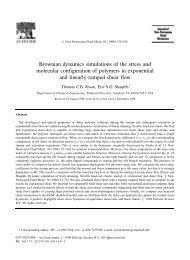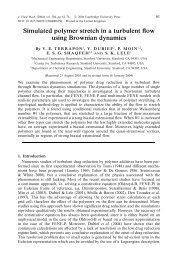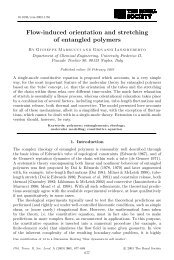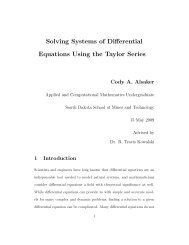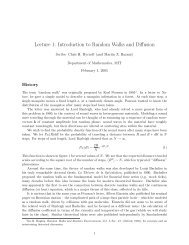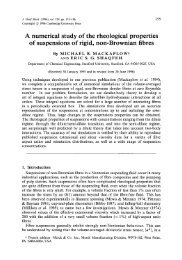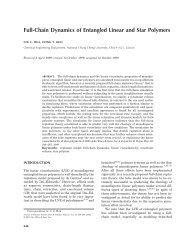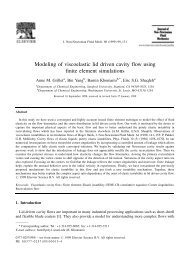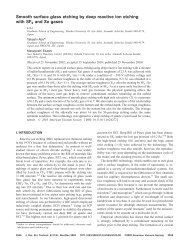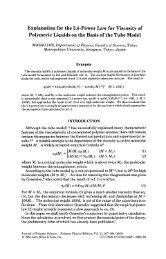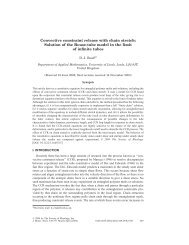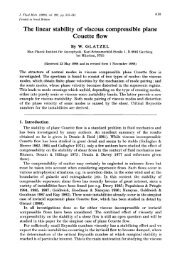Molecular modelling of entangled polymer fluids under flow The ...
Molecular modelling of entangled polymer fluids under flow The ...
Molecular modelling of entangled polymer fluids under flow The ...
Create successful ePaper yourself
Turn your PDF publications into a flip-book with our unique Google optimized e-Paper software.
3.2. SINGLE MODE POM-POM MODEL 51<br />
γ . [sec -1 ]<br />
0.25<br />
0.2<br />
1.225<br />
0.7<br />
3.0<br />
5.0<br />
0.25<br />
affine<br />
S xy<br />
0.15<br />
0.1<br />
0.05<br />
0<br />
0 5 10 15 20<br />
time [sec]<br />
Figure 3.1: Evolution <strong>of</strong> S xy for simple shear shear, ˙γ = 1sec −1 . Affine deformation<br />
corresponds to τ b = ∞ . <strong>The</strong> thin solid line corresponds to the value <strong>of</strong> τ b for which<br />
the steady state value <strong>of</strong> S xy is maximised.<br />
value <strong>of</strong> S xy can be shown to be<br />
τ b(max) =<br />
√<br />
3/2<br />
. (3.3)<br />
˙γ<br />
This is shown as the thin solid line in figure 3.1. <strong>The</strong> dashed curves in figure 3.1, which<br />
correspond to values <strong>of</strong> τ b other than τ b(max) , all fall below the τ b(max) curve in steady<br />
state. When τ b < τ b(max) the rapid reptation means that the <strong>flow</strong> is not fast enough,<br />
on average, to orientate the backbones significantly before they relax. For τ b > τ b(max)<br />
the backbones are orientated through the optimum angle but the <strong>flow</strong> then continues<br />
to orientate them towards the x-axis before the slow orientation relaxation produces<br />
a dynamic equilibrium.<br />
<strong>The</strong> contribution <strong>of</strong> a single backbone to S xy is maximised<br />
when it lies in the x-y plane, making an angle <strong>of</strong> 45 o with the x-axis. At this angle<br />
the contribution to S xy is 1/2. Note that even in the affine case S xy never reaches this<br />
value since, due to the isotropic initial distribution <strong>of</strong> backbones, all <strong>of</strong> the backbones<br />
will never simultaneously point in the same direction.<br />
For nearly exponential shear the full analytic solution for S xy is<br />
(1 + 2 α τ b ) ( e αt − 1 )<br />
S xy =<br />
),<br />
(6 ατ b + 2ατ b e 2αt + 2ατ b e − t<br />
τ b − 4ατ b e (α− 1 )t − τ b + 2e t<br />
τ b − 2e (α− 1 )t τ b + 9 +<br />
3<br />
ατ b<br />
(3.4)<br />
with α as defined in equation 3.1. Figure 3.2 shows plots <strong>of</strong> S xy for varying backbone<br />
orientation times. <strong>The</strong> solutions for S xy separate into two distinct regimes. For 1/τ b < α



